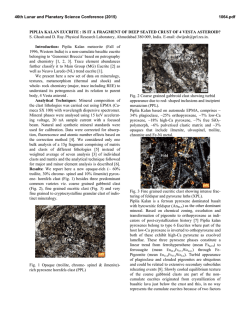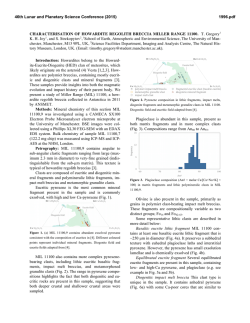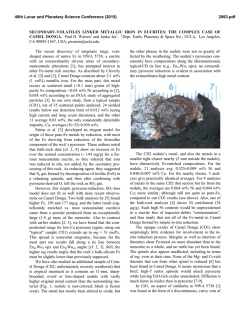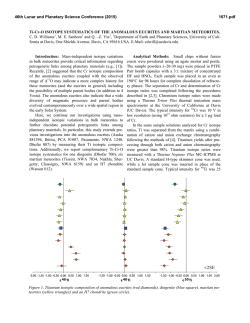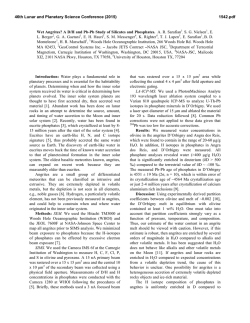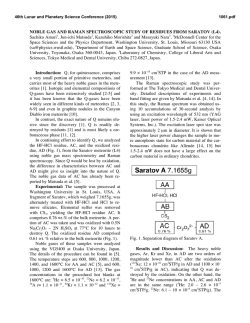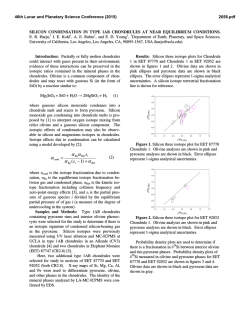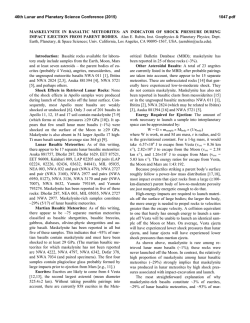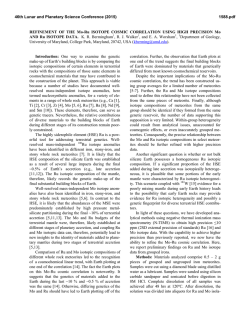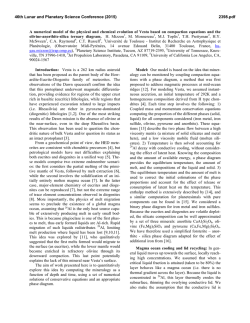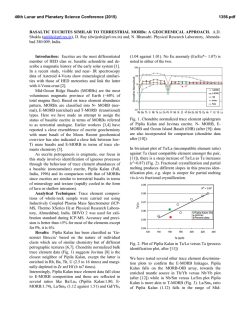
PETROLOGY OF ANOMALOUS EUCRITES. D. W. - USRA
46th Lunar and Planetary Science Conference (2015) 1933.pdf PETROLOGY OF ANOMALOUS EUCRITES. D. W. Mittlefehldt1, Z. X. Peng2 and D. K. Ross2, 1 Astromaterials Research Office, NASA Johnson Space Center, Houston, TX, USA ([email protected]), 2Jacobs Technology, NASA Johnson Space Center, Houston TX, USA. Introduction: Most mafic achondrites can be broadly categorized as being “eucritic”, that is, they are composed of a ferroan low-Ca clinopyroxene, high-Ca plagioclase and a silica phase [1]. They are petrologically distinct from angritic basalts, which are composed of high-Ca, Al-Ti-rich clinopyroxene, Carich olivine, nearly pure anorthite and kirschsteinite [2], or from what might be called brachinitic basalts, which are composed of ferroan orthopyroxene and high-Ca clinopyroxene, intermediate-Ca plagioclase and ferroan olivine [3]. Because of their similar mineralogy and composition, eucrite-like mafic achondrites formed on compositionally similar asteroids under similar conditions of temperature, pressure and oxygen fugacity. Some of them have distinctive isotopic compositions and petrologic characteristics that demonstrate formation on asteroids different from the parent of the HED clan (e.g., Ibitira, Northwest Africa (NWA) 011 [4-6]). Others show smaller oxygen isotopic distinctions but are otherwise petrologically and compositionally indistinguishable from basaltic eucrites (e.g., Pasamonte, Pecora Escarpment (PCA) 91007 [5, 7]). The degree of uniformity in Δ17O of eucrites and diogenites is one piece of evidence considered to favor of a magma-ocean scenario for their petrogenesis [5, 7]. Given that the O isotopic differences separating Pasamonte and PCA 91007 from other eucrites are small, and that there is an absence of other distinguishing characteristics, a legitimate question is: Did the HED parent asteroid fail to homogenize via a magma-ocean stage, thus explaining outliers like Pasamonte? We are initiating a program of study of anomalous eucrite-like achondrites as one part of our effort to seek a resolution of this issue. Here we present preliminary petrologic information on Asuka (A-) 881394, Elephant Moraine (EET) 87520 and EET 87542. We will have studied several more by conference time. Petrology and Pyroxene Composition: A881394 is a coarse-grained, equigranular-textured metagabbro [8]. Bulk rock compositions show it is a cumulate with an anomalously low Na content [9, 10], and its O- and Cr-isotopic compositions overlap those of anomalous eucrite Bunburra Rockhole [7, 11-13]. EET 87520 is an unbrecciated, coarse-grained, ophiticsubophitic gabbro/diabase said to contain Mg-rich pyroxenes like those of some cumulate eucrites [14]. However, it has incompatible element contents like those of basaltic eucrites [15]. EET 87542 is a brecci- ated eucrite with lithic clasts having relict ophitic texture. While it was not remarked upon in the initial description, its average pyroxene is more magnesian than typical for basaltic eucrites [16]. As is common to eucrites, the initial magmatic pigeonite grains in the mafic rocks studied here are now composed of high-Ca pyroxene exsolutions and lowCa pyroxene hosts. The average phase compositions for each of these meteorites (Fig. 1) shows A-881394 is more magnesian than cumulate eucrite Moore County, while EET 87520 is ferroan, like basaltic eucrite Sioux County. Pyroxenes in EET 87542 are similar to those in Moore County. The Fe/Mn ratio of A-881394 low-Ca pyroxene is like that of Moore County, while that of EET 87520 is like those of basaltic eucrites (Fig. 2). Low-Ca pyroxenes in EET 87542 have very low Fe/Mn ratios, even compared to secondary mafic igneous clasts in mesosiderites that were reduced by interaction with the metallic phase [17]. Titanium-Al relationships for EET 87520 and EET 87542 are consistent with normal eucrites, while A-881394 has a trend of much lower Ti/Al (Fig. 3). Figure 1. Compositions of average low-Ca and highCa pyroxenes in anomalous eucrites compared to fields for Moore County [17], Ibitira [6] and Sioux County [10]. EET 87520 (NL) from [14]. Figure 2. Fe/Mn vs. Fe/Mg for low-Ca pyroxenes in anomalous eucrites compared to normal eucrites and 46th Lunar and Planetary Science Conference (2015) basaltic and gabbroic clasts from mesosiderites [6, 10, 17]. Figure 3. Ti vs. Al for anomalous eucrites compared to fields for Moore County [17], Ibitira [6] and Sioux County [10]. Discussion: Although the bulk composition and isotopic characteristics of cumulate gabbro A-881394 distinguish it from cumulate eucrites [7, 9, 10, 13], pyroxene compositions are well within cumulate eucrite norms for quadrilateral components and Fe/Mn (Figs. 1, 2). It is distinct in Ti-Al (Fig. 3). The Δ17O of A-881394 lies 15σ outside the HED mean [7]. The unbrecciated metagabbro texture [8] and ancient age [18] of this rock preclude mixing of HED and impactor oxygen as an explanation. The more likely scenario for A-881394 is that it was formed on a different asteroid than that of the HEDs, but which had a similar oxygen fugacity allowing for a pyroxene Fe/Mn that is indistinguishable from HEDs. The initial description of EET 87520 suggested that it has pyroxenes with compositions like those of Moore County [14]. However, the compositions we determined (Figs. 1, 2) and those by [19] match the pyroxenes of basaltic eucrites. This is consistent with the texture [14], and the incompatible element contents [15] that are like those of basaltic eucrites. EET 87520 is a normal basaltic eucrite. The reason for the original identification as being Mg-rich is unresolved. We note that the pyroxene compositions given in the initial description [14] (EET 87520 (NL); Fig. 1) are good matches to our data for EET 87542. EET 87542 contains pyroxenes that are more magnesian than typical for basaltic eucrites such as Sioux County (Fig. 1), and with anomalously low Fe/Mn (Fig. 2). The Ti-Al ratios of the pyroxenes are equivalent to those of Sioux County and Moore County (Fig. 3). Pyroxene compositions in relict ophitic/subophitic clasts and in the fragmental matrix are identical indicating thorough equilibration. Original coarse igneous pyroxene grains have been recrystallized to equant, ~100 µm grains that are surrounded by fine-grained silica and metal (Fig. 4). This suggests that the anomalous Fe/Mn might be the result of subsolidus reduction 1933.pdf of FeO to form Fe metal, silica and magnesian pyroxene with low Fe/Mn. At present, EET 87542 appears to be a normal basaltic eucrite that underwent unusual subsolidus processing. Figure 4. Backscattered electron image of EET 87542. References: [1] Mittlefehldt D. W. (2014) Chemie Erde – Geochem., in press. [2] Keil K. (2012) Chemie Erde – Geochem. 72, 191-218. [3] Shearer C. K. et al. (2010) Geochim. Cosmochim. Acta 74, 1172-1199. [4] Yamaguchi A. et al. (2002) Science 296, 334-336. [5] Greenwood R. C. et al. (2005) Nature 435, 916918. [6] Mittlefehldt D. W. (2005) Meteoritics & Planet. Sci. 40, 665-677. [7] Scott E. R. D. et al. (2009) Geochim. Cosmochim. Acta 73, 5835-5853. [8] Takeda H. et al. (1997) Antarctic Meteorite Research 10, 401-413. [9] Warren P. H. et al. (2009) Geochim. Cosmochim. Acta 73, 5918-5943. [10] Mittlefehldt D. W., unpublished data. [11] Bland P. A. et al. (2009) Science 325, 1525-1527. [12] Benedix G. K. et al. (2014) LPS XLV, Abstract #1650. [13] Sanborn M. E. and Yin Q.-Z. (2014) LPS XLV, Abstract #2018. [14] Mason B. (1988) Antarctic Meteorite Newsletter 11(2), 20. [15] Mittlefehldt D. W. & Lindstrom M. M. (2003) Geochim. Cosmochim. Acta 67, 1911-1934. [16] Mason B. (1989) Antarctic Meteorite Newsletter 12(1), 14. [17] Mittlefehldt D. W. (1990) Geochim. Cosmochim. Acta 54, 1165-1173. [18] Wadhwa M. et al. (2009) Geochim. Cosmochim. Acta 73, 5189-5201. [19] Mayne R. G. et al. (2009). Geochim. Cosmochim. Acta 73, 794-819.
© Copyright 2026
